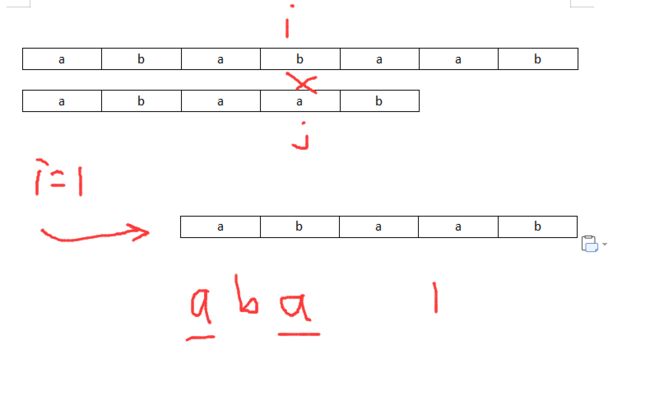示例:
1. 已知字符串str1="acabaabaabcacaabc",求str2="abaabcac"是否在字符串str1中?
2. DNA病毒检测。已知患者DNA序列求病毒DNA序列是否在患者DNA中出现过?病毒DNA为环状结构(即首尾相连)。
此文以问题1为例进行解答。
一、BF算法:
即暴力检测法,从字符串第一个字符开始和匹配字符串进行比较如果不同,则从字符串第二个位置开始比较直到结束。
BF算法思想很简单,直接列出代码实现:
static void Main(string[] args) { string str = "acabaabaabcacaabc";//"aaabaaaaaab"; string mo = "abaabc";//"aaaab";int flag;//表示查询结果 flag = BF(str, mo, 0); if (flag != -1) Console.WriteLine("匹配成功!" + " 下标为: " + flag); else Console.WriteLine("匹配失败!"); }
private static int BF(string str, string mo, int v) { int i = v ,j = 0; while (i < str.Length && j < mo.Length) { if (str[i] == mo[j]) { i++; j++; } else { i = i - j + 1; j = 0; } } if (j >= mo.Length) return i - mo.Length; else return -1; }
二、KMP算法:
如图:
在检测中发现i和j标记的元素不同,此时如果是BF算法直接ii= i-j+1,j = 0.但是KMP算法思想是让i下标不变,j下标变化,即可以理解为数组str2右移尽可能少的单位。
问题来了,如何知道要移动多少呢?
如图,我们可以知道,在数组str2中j下标之前的所有元素都和数组str1的对应位匹配,那么我们只要保证,将str2数组向右移动k,使得在str2中j=k元素之前的元素依旧匹配即可。因此引入
前缀和后缀的概念,前缀:元素的真子集 ,后缀:元素的反向真子集。即如aba三个元素,最长前缀为ab,最长后缀为ba。但是只有前缀a和后缀a相同所以str2的第四个元素的
next值为1;也就是当匹配到str[3]不同于str1时,此时j下标变为1即str2向右移动到j==下标1。
为此我们只需要根据str2得到next数组就行。即得到str2的最大匹配前后缀个数。默认a[0]=0;即变化值为next值-1.因为next值是在字符串下标从1开始,我们开发通常下标从0开始
代码如下:
static void Main(string[] args) { string str = "acabaabaabcacaabc";//"aaabaaaaaab"; string mo = "abaabc";//"aaaab"; int[] next=new int[mo.Length]; int flag;//表示查询结果 setNext(mo, next); foreach (var item in next) { Console.Write(item + " "); } Console.WriteLine(); flag = KMP(str, mo, 0, next); if (flag != -1) Console.WriteLine("匹配成功!" + " 下标为: " + flag); else Console.WriteLine("匹配失败!"); }
private static void setNext(string mo, int[] next) { int i = 0, j = -1; next[0] = -1; while (i < mo.Length - 1) { if (j == -1 || mo[i] == mo[j]) { i++; j++; next[i] = j; } else j = next[j]; } }
private static int KMP(string str, string mo, int v,int[] next) { int i = v, j = 0; while (i < str.Length && j < mo.Length) { if (j==-1 || str[i] == mo[j]) { i++; j++; } else { j = next[j]; } } if (j >= mo.Length) return i - mo.Length; else return -1; }
//进一步对next数组优化
private static void setNextVal(string mo, int[] next) { int i = 0, j = -1; next[0] = -1; while (i < mo.Length-1) { if (j == -1 || mo[i] == mo[j]) { i++; j++; if (mo[i] != mo[j]) next[i] = j; else next[i] = next[j]; } else j = next[j]; } }


